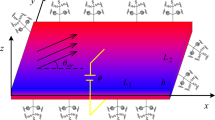Abstract
The numerical solution of the two-criteria variational problem of the body contour with minimum radiation heat flux and wave drag is obtained in the class of axisymmetric and plane slender bodies in hypersonic flow. Solutions obtained using the Pareto, ideal point and minimax methods are compared. It is shown that in the class of axisymmetric slender bodies the optimum body gives a decrease in the radiation heat flux as compared with a cone of up to 15% for the Pareto method, up to 13% for the ideal point method, and up to 5% for the minimax method. A solution is also obtained in the subclass of power-law slender bodies and it is shown that the optimum power-law bodies are inferior, as compared with the optimum bodies from the general class of such bodies, in reducing both radiation heating and resistance.
Similar content being viewed by others
References
M.A. Arguchintseva and N.N. Pilyugin, Extremum Problems of Radiation Gas Dynamics [in Russian] (Moscow University Press, Moscow, 1997).
M.A. Arguchintseva and N.N. Pilyugin, “Optimization of the Shape of a Three-Dimensional Body with respect to Radiation Heat Flux,” Teplofizika Vysokikh Temperatur 40(4), 603–616 (2002).
M.A. Arguchintseva and A.V. Daneev, Optimization of the Outer Geometry of an Aircraft in Problems of Supersonic Aerodynamics [in Russian] (Publishing House of the East Siberian Institute of the Russian Ministry of Internal Affairs, Irkutsk, 1999).
O.A. Gilman and N.N. Pilyugin, “Pareto-Optimum Shapes of Axisymmetric Bodies Moving at High Supersonic Velocities,” Prikl. Mat. Mekh. 55(2), 290–297 (1991).
Yu.A. Vedernikov and V.A. Shchepanovskii, Optimization of Rheo-Gas-Dynamic Systems [in Russian] (Nauka, Novosibirsk, 1995).
A.N. Kraiko, D.E. Pudovnikov, and G.E. Yakunina, Theory of Almost Optimum Aerodynamic Shapes [in Russian] (Yanus-K, Moscow, 2001).
N.A. Ostapenko, Optimum Shapes of Bodies Moving in Dense Media [in Russian] (Vladar, Moscow, 1997).
Theory of Optimum Aerodynamic Shapes, Ed. by A. Miele (Academic Press, New York, 1965).
N.N. Pilyugin and G.A. Tirskii, Dynamics of an Ionized Radiating Gas [in Russian] (Moscow University Press, Moscow, 1989).
V.D. Nogin, I.O. Protodyakonov, and I.I. Evlampiev, Fundamentals of Optimization Theory [in Russian] (Vysshaya Shkola, Moscow, 1986).
L.E. Elsgolts, Differential Equations and Calculus of Variations [in Russian] (Nauka, Moscow, 1965).
Additional information
Original Russian Text © M.A. Arguchintseva, N.N. Pilyugin, 2008, published in Izvestiya Rossiiskoi Akademii Nauk, Mekhanika Zhidkosti i Gaza, 2008, Vol. 43, No. 4, pp. 141–150.
Rights and permissions
About this article
Cite this article
Arguchintseva, M.A., Pilyugin, N.N. Optimization of the shape of a body with respect to two criteria: Radiation heat flux and wave drag. Fluid Dyn 43, 625–633 (2008). https://doi.org/10.1134/S0015462808040157
Received:
Published:
Issue Date:
DOI: https://doi.org/10.1134/S0015462808040157




